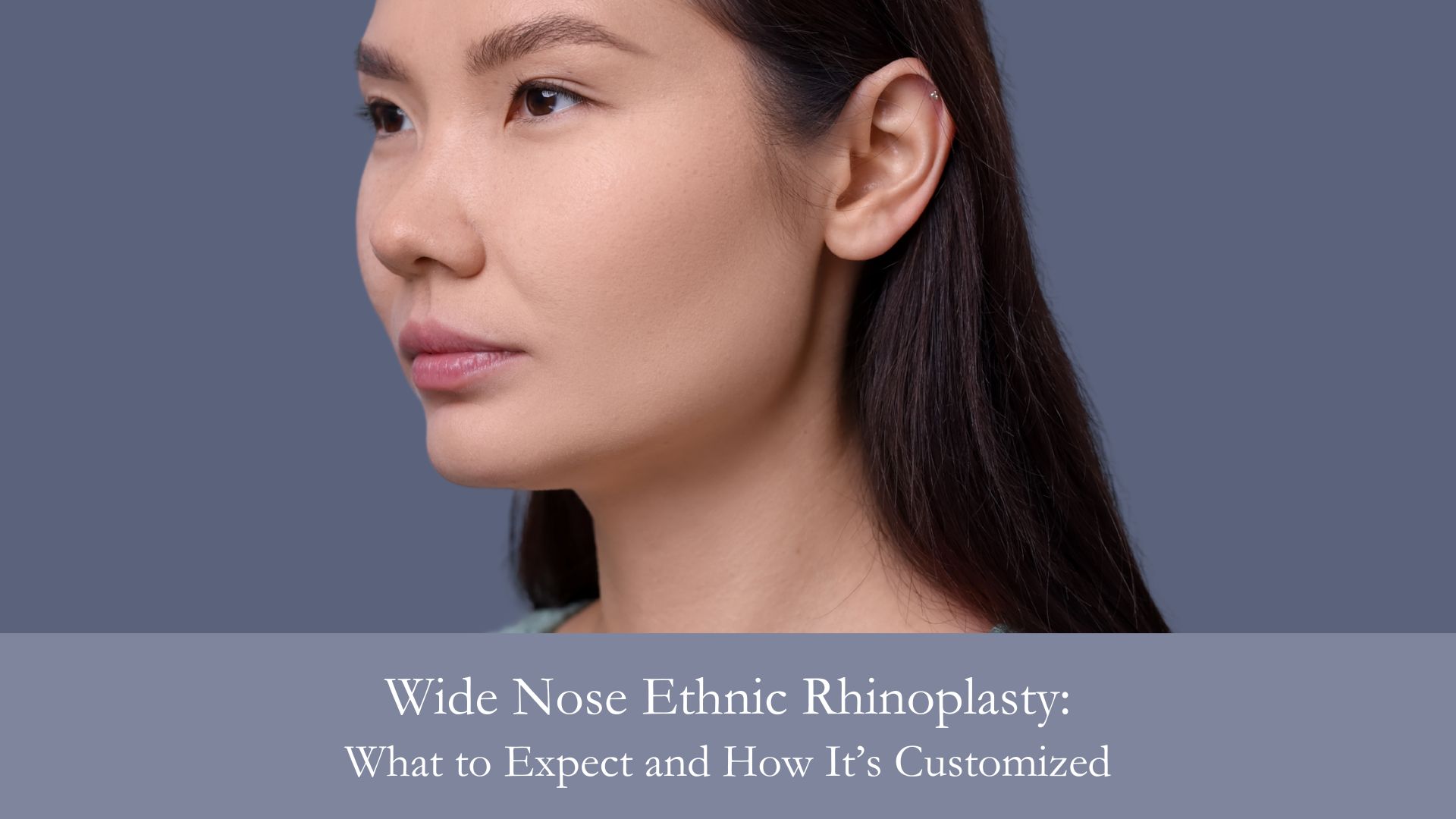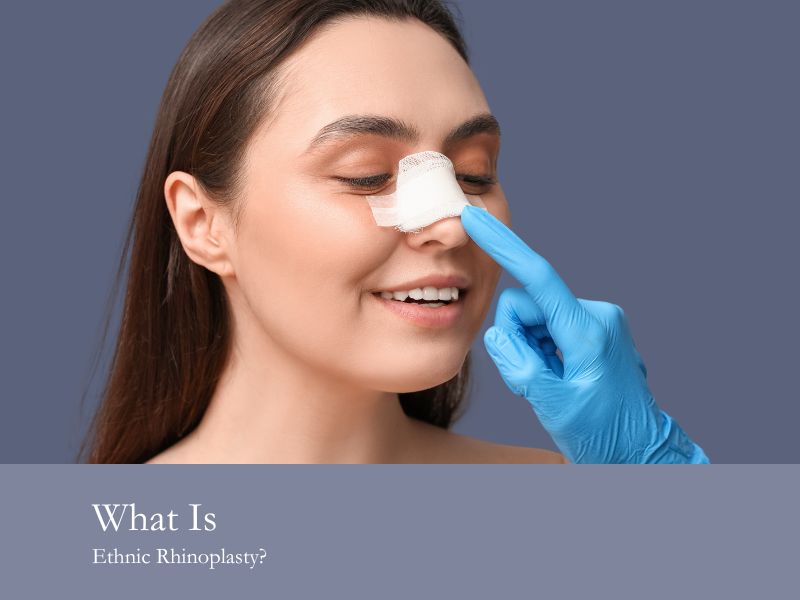Wide nose ethnic rhinoplasty is a specialized form of rhinoplasty surgery designed to address the unique nasal characteristics of ethnic patients while preserving cultural identity and enhancing facial harmony.
Whether you’re of African, Asian, Middle Eastern, or Hispanic descent, a skilled ethnic rhinoplasty surgeon can create a customized surgical plan that respects your ethnic background and enhances your natural facial features.
Unlike caucasian rhinoplasty, ethnic rhinoplasty involves working with thick skin, a low nasal bridge, or a bulbous nasal tip, all features that require different rhinoplasty techniques to achieve a balanced, natural-looking outcome.
Table of Contents
What Is Ethnic Rhinoplasty?
Ethnic rhinoplasty is a type of facial plastic surgery tailored to individuals with non-Caucasian heritage. The goal isn’t to erase your ethnic identity, but to refine your nasal structure to complement your overall look. For many ethnic rhinoplasty patients, this means addressing a wide nose, flared nostrils, or poor nasal projection while preserving culturally distinct aesthetics.
In many cases, ethnic noses feature unique bone and cartilage frameworks that require precise adjustments, not reduction. This is why rhinoplasty specialists must be trained in both surgical skill and cultural sensitivity.
Common Concerns Addressed
- African American rhinoplasty often focuses on refining a bulbous tip, reducing flared nostrils, and increasing nasal projection. Because African American patients often have thick skin and weaker cartilage support, tip grafts and cartilage reshaping are essential.
- Asian rhinoplasty may target a low nasal bridge, subtle tip definition, and enhanced profile. Many asian patients also seek increased height in the nose to improve symmetry with other facial features.
- Middle Eastern rhinoplasty can include smoothing a nasal hump, refining the nasal tip, or correcting a deviated septum. Middle Eastern patients may also request subtle changes to soften a more prominent nasal structure while maintaining identity.
- Latino rhinoplasty and Hispanic rhinoplasty often aim to bring definition to a wide nasal base or under-projected nose tip. In these procedures, it’s critical to balance refinement with preservation of ethnic beauty.
Choosing the Right Ethnic Rhinoplasty Surgeon
A board-certified facial plastic surgeon or plastic surgeon with extensive experience in ethnic rhinoplasty surgery is essential. These experts understand how nasal anatomy differs between populations and how to adapt rhinoplasty techniques for African American patients, asian patients, Hispanic patients, Middle Eastern patients, and others.
When you seek ethnic rhinoplasty, look for a surgeon who has performed successful ethnic nose jobs, uses cartilage grafts for structural support, and offers both open rhinoplasty and closed rhinoplasty depending on your case.
An ethnic rhinoplasty doctor should have a diverse portfolio of before-and-after cases and the ability to explain how outcomes are tailored to different ethnic noses. Cultural awareness, anatomical expertise, and artistic precision must work together to deliver safe and beautiful outcomes.
What to Expect During the Rhinoplasty Procedure
Initial Consultation
During your ethnic rhinoplasty consultation, your surgeon will evaluate your nasal structure, discuss your aesthetic goals, and identify whether non-surgical rhinoplasty or rhinoplasty surgery is the better fit. They’ll also consider other procedures like eyelid surgery or neck surgery to achieve full facial harmony if appropriate.
A thorough initial consultation should include photo analysis, 3D imaging, and a discussion of your ethnic identity and what features you’d like to retain or enhance.
Surgical Technique
The rhinoplasty procedure is usually performed under general anesthesia. Tip grafts, cartilage reshaping, and cartilage grafts may be used to address a bulbous nasal tip, define the nasal bridge, or correct airflow issues from a deviated septum.
Many ethnic rhinoplasty surgeons use advanced rhinoplasty techniques to ensure long-term results with minimal scarring. If the nose has been altered before, a revision rhinoplasty may be necessary to address concerns from prior work.
Each surgical plan is uniquely constructed. For instance, asian noses may require dorsal augmentation using natural cartilage, while African American rhinoplasty may benefit from nostril narrowing techniques that preserve support and structure.
Recovery Timeline
After surgery, most patients experience minimal swelling and are advised to rest with their head elevated. Bruising may last a week or two, and noticeable results typically settle over two to three weeks, with final results visible in a few months.
Ethnic rhinoplasty recovery may vary slightly due to skin thickness and skin type. Some Middle Eastern descent and African American patients may experience prolonged swelling in the tip, and require extended follow-up to track refinement.
Pain medication is prescribed for early recovery, and patients should avoid strenuous activity during the healing phase. Attending follow-up appointments ensures proper healing and early identification of complications.
FAQs: Wide Nose Ethnic Rhinoplasty
What makes ethnic rhinoplasty different from other nose jobs?
Ethnic rhinoplasty takes into account the nasal anatomy and skin thickness of diverse populations. It prioritizes maintaining cultural features while improving function and appearance.
Is revision rhinoplasty common in ethnic cases?
Yes. Patients who underwent a rhinoplasty procedure that didn’t account for their ethnic traits often seek a revision rhinoplasty to restore structure and achieve more natural-looking results.
Can I get a nose job without erasing my ethnic identity?
Absolutely. A qualified rhinoplasty surgeon will tailor the procedure to your specific features and goals, never erasing your ethnic identity but enhancing your natural beauty.
How long does recovery take?
Recovery takes a few weeks, but subtle changes continue to develop over several months. Final results may take up to a year, depending on your skin and healing response.
Is non-surgical rhinoplasty an option for ethnic noses?
Yes, for some ethnic rhinoplasty patients, non-surgical rhinoplasty using fillers can address minor concerns like a nasal hump or nasal bridge asymmetry. However, results are temporary.
Ready for Your Wide Ethnic Rhinoplasty Consultation?
If you’re considering wide nose ethnic rhinoplasty, working with an experienced surgeon who understands your goals and background is important. At Zahedi Plastic Surgery, we are proud to be trusted experts in ethnic rhinoplasty and all nose surgery and plastic surgery procedures that enhance your look while honoring your unique heritage.
We proudly serve many patients of Middle Eastern descent, African American, asian, and Hispanic backgrounds, providing personalized care and lasting, natural results.
Whether you’re dealing with flared nostrils, a bulbous tip, or simply want to refine your nasal structure while preserving your ethnic identity, we’re here to guide you from your initial consultation through to your final outcome.
Schedule your consultation today and take the first step toward renewed confidence and refined beauty.




